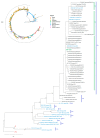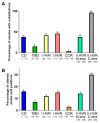Respiratory Syncytial Virus G Protein Sequence Variability among Isolates from St. Petersburg, Russia, during the 2013-2014 Epidemic Season
- PMID: 33477301
- PMCID: PMC7830914
- DOI: 10.3390/v13010119
Respiratory Syncytial Virus G Protein Sequence Variability among Isolates from St. Petersburg, Russia, during the 2013-2014 Epidemic Season
Abstract
Human respiratory syncytial virus (RSV) is the most common cause of upper and lower respiratory tract infections in infants and young children. It is actively evolving under environmental and herd immunity influences. This work presents, for the first time, sequence variability analysis of RSV G gene and G protein using St. Petersburg (Russia) isolates. Viruses were isolated in a cell culture from the clinical samples of 61 children hospitalized (January-April 2014) with laboratory-confirmed RSV infection. Real-time RT-PCR data showed that 56 isolates (91.8%) belonged to RSV-A and 5 isolates (8.2%) belonged to RSV-B. The G genes were sequenced for 27 RSV-A isolates and all of them belonged to genotype ON1/GA2. Of these RSV-A, 77.8% belonged to the ON1(1.1) genetic sub-cluster, and 14.8% belonged to the ON1(1.2) sub-cluster. The ON1(1.3) sub-cluster constituted a minor group (3.7%). Many single-amino acid substitutions were identified in the G proteins of St. Petersburg isolates, compared with the Canadian ON1/GA2 reference virus (ON67-1210A). Most of the amino acid replacements were found in immunodominant B- and T-cell antigenic determinants of G protein. These may affect the antigenic characteristics of RSV and influence the host antiviral immune response to currently circulating viruses.
Keywords: G protein variability; ON1/GA2 genotype; human respiratory syncytial virus; phylogenetic analysis.
Conflict of interest statement
The authors declare no conflict of interest. Funding sources had no role in: study design; data collection, analysis, or interpretation; or submission/publication decisions.
Figures



Similar articles
-
Spread and Evolution of Respiratory Syncytial Virus A Genotype ON1, Coastal Kenya, 2010-2015.Emerg Infect Dis. 2017 Feb;23(2):264-271. doi: 10.3201/eid2302.161149. Emerg Infect Dis. 2017. PMID: 28098528 Free PMC article.
-
The genetic variability of glycoproteins among respiratory syncytial virus subtype A in China between 2009 and 2013.Infect Genet Evol. 2014 Oct;27:339-47. doi: 10.1016/j.meegid.2014.07.030. Epub 2014 Aug 7. Infect Genet Evol. 2014. PMID: 25109878
-
Novel respiratory syncytial virus (RSV) genotype ON1 predominates in Germany during winter season 2012-13.PLoS One. 2014 Oct 7;9(10):e109191. doi: 10.1371/journal.pone.0109191. eCollection 2014. PLoS One. 2014. PMID: 25290155 Free PMC article.
-
Importance of Virus Characteristics in Respiratory Syncytial Virus-Induced Disease.Immunol Allergy Clin North Am. 2019 Aug;39(3):321-334. doi: 10.1016/j.iac.2019.04.001. Epub 2019 May 22. Immunol Allergy Clin North Am. 2019. PMID: 31284923 Free PMC article. Review.
-
Respiratory syncytial virus genetic and antigenic diversity.Clin Microbiol Rev. 2000 Jan;13(1):1-15, table of contents. doi: 10.1128/CMR.13.1.1. Clin Microbiol Rev. 2000. PMID: 10627488 Free PMC article. Review.
Cited by
-
Epidemiological and clinical profile of viral respiratory infections in children under 5 years at pre- and post-COVID-19 era in Praia, Cabo Verde.Trop Med Int Health. 2025 Jul;30(7):694-703. doi: 10.1111/tmi.14125. Epub 2025 May 20. Trop Med Int Health. 2025. PMID: 40390559 Free PMC article.
-
All Eyes on the Prefusion-Stabilized F Construct, but Are We Missing the Potential of Alternative Targets for Respiratory Syncytial Virus Vaccine Design?Vaccines (Basel). 2024 Jan 18;12(1):97. doi: 10.3390/vaccines12010097. Vaccines (Basel). 2024. PMID: 38250910 Free PMC article. Review.
-
Molecular Epidemiology and Genetic Diversity of Human Respiratory Syncytial Virus in Sicily during Pre- and Post-COVID-19 Surveillance Seasons.Pathogens. 2023 Aug 28;12(9):1099. doi: 10.3390/pathogens12091099. Pathogens. 2023. PMID: 37764907 Free PMC article.
-
Robust and sensitive amplicon-based whole-genome sequencing assay of respiratory syncytial virus subtype A and B.Microbiol Spectr. 2024 Apr 2;12(4):e0306723. doi: 10.1128/spectrum.03067-23. Epub 2024 Feb 27. Microbiol Spectr. 2024. PMID: 38411056 Free PMC article.
References
-
- Bont L., Checchia P.A., Fauroux B., Figueras-Aloy J., Manzoni P., Paes B., Simões E.A., Carbonell-Estrany X. Defining the Epidemiology and Burden of Severe Respiratory Syncytial Virus Infection Among Infants and Children in Western Countries. Infect. Dis. Ther. 2016;5:271–298. doi: 10.1007/s40121-016-0123-0. - DOI - PMC - PubMed
-
- Manzoni P., Figueras-Aloy J., Simões E.A.F., Checchia P.A., Fauroux B., Bont L., Paes B., Carbonell-Estrany X. Defining the Incidence and Associated Morbidity and Mortality of Severe Respiratory Syncytial Virus Infection Among Children with Chronic Diseases. Infect. Dis. Ther. 2017;6:383–411. doi: 10.1007/s40121-017-0160-3. - DOI - PMC - PubMed
-
- Nair H., Nokes D.J., Gessner B.D., Dherani M., Madhi S.A., Singleton R.J., O’Brien K.L., Roca A., Wright P.F., Bruce N., et al. Global burden of acute lower respiratory infections due to respiratory syncytial virus in young children: A systematic review and meta-analysis. Lancet. 2010;375:1545–1555. doi: 10.1016/S0140-6736(10)60206-1. - DOI - PMC - PubMed
-
- Karron R.A. In: Vaccines. 6th ed. Plotkin S.A., Orenstein W.A., Offit P.A., editors. Elsevier Inc. Saunders; Philadelphia, PA, USA: 2012. pp. 1146–1153.
Publication types
MeSH terms
Substances
LinkOut - more resources
Full Text Sources
Other Literature Sources
Medical
Miscellaneous

